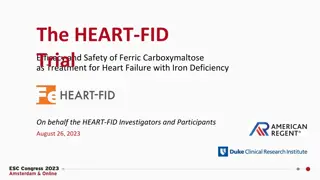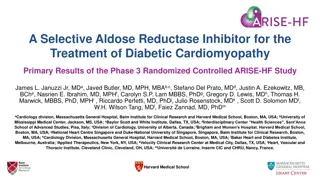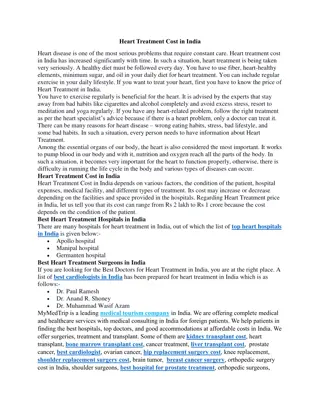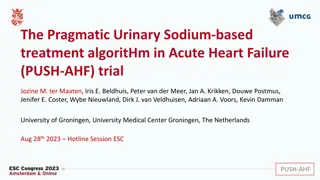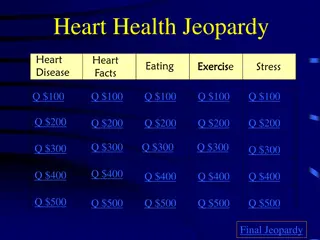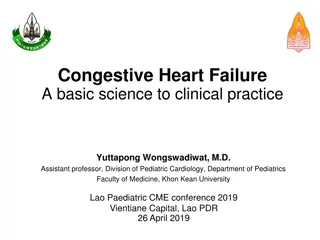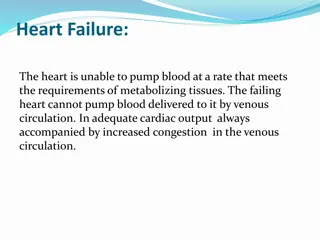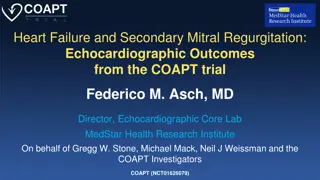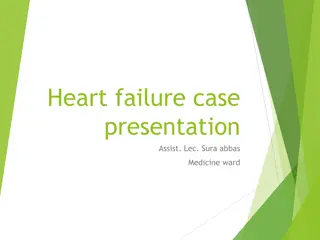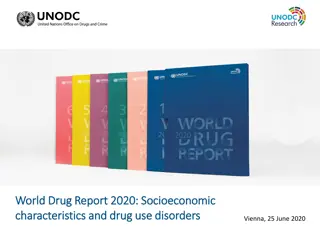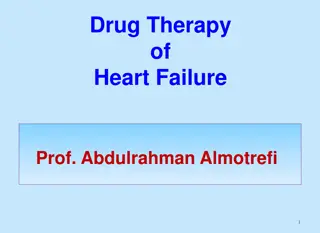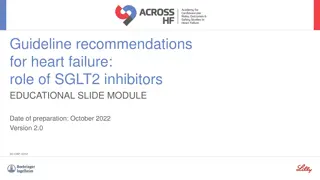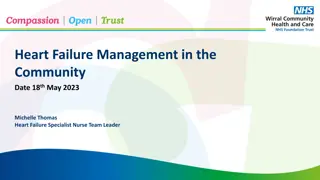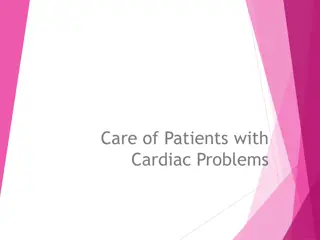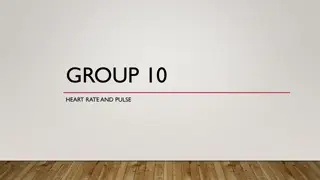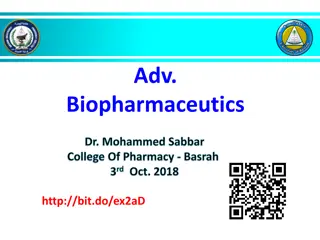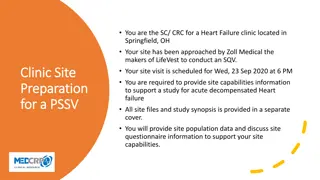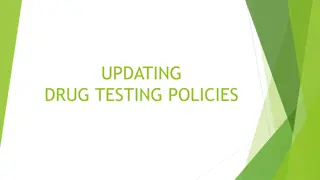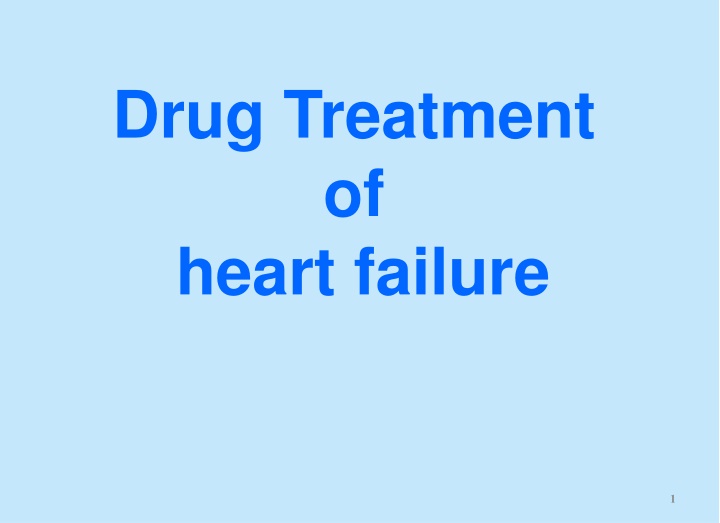
Drug Treatment of Heart Failure
Explore the drug treatment options for heart failure, including the different classes of drugs, their mechanisms of action, pharmacological effects, clinical uses, adverse effects, and interactions. Learn about the causes, symptoms, and pathophysiology of heart failure, as well as factors affecting cardiac output. Discover drugs used to increase contractility in the treatment of heart failure.
Uploaded on | 0 Views
Download Presentation

Please find below an Image/Link to download the presentation.
The content on the website is provided AS IS for your information and personal use only. It may not be sold, licensed, or shared on other websites without obtaining consent from the author. If you encounter any issues during the download, it is possible that the publisher has removed the file from their server.
You are allowed to download the files provided on this website for personal or commercial use, subject to the condition that they are used lawfully. All files are the property of their respective owners.
The content on the website is provided AS IS for your information and personal use only. It may not be sold, licensed, or shared on other websites without obtaining consent from the author.
E N D
Presentation Transcript
Drug Treatment of heart failure 1
Prof. Abdulrahman Almotrefi Prof. Azza El-Medani
Learning objectives By the end of this lecture, students should be able to: - Describe the different classes of drugs used for treatment of acute & chronic heart failure and their mechanism of action - Understand their pharmacological effects, clinical uses, adverse effects and their interactions with other drugs.
HEART FAILURE HEART FAILURE ? Inability of the heart to maintain an adequate cardiac output to meet the metabolic demands of the body.
CAUSES OF HEART FAILURE CAUSES OF HEART FAILURE
Heart failure symptoms - Tachycardia - Decreased exercise tolerance (rapid fatigue) - Dyspnea ( pulmonary congestion) - Peripheral edema - Cardiomegaly 6
Dyspnea Oedema of lower limbs
Force of contraction Low C.O. Carotid sinus firing Activate sympathetic system Sympathetic discharge Activate renin-angiotensin- Aldosterone system Remodeling Salt & Water Retention Volume expansion Vasoconstriction Venous VC Force of Cardiac .cont. HR . Arterial VC Preload Preload After load C.O. Via compensation Pathophysiology of CHF
Factors affecting cardiac output and Heart Failure 1- Cardiac contractility 2- Preload 3- Afterload 4- Heart rate 10
Drugs used in the treatment of heart failure Drugs that increase contractility Drugs that increase contractility Cardiac glycosides Phosphodiesterase inhibitors - adrenoceptor agonists
Drugs that decrease preload Drugs that decrease preload Diuretics Venodilators
Drugs that decrease Drugs that decrease afterload afterload Arteriolodilators
Drugs that decrease preload & Drugs that decrease preload & afterload afterload Combined arteriolo- and venodiators: Angiotensin converitng enzyme (ACE) inhibitors Angiotensin receptor antagonists 1-adrenoceptor antagonists Direct vasodilators
CARDIAC GLYCOSIDES Digoxin / Digitoxin / Ouabain Digitalis Lanata
CARDIAC GLYCOSIDES Mechanism of action - Inhibit Na+ / K+ ATPase enzyme 16
CARDIAC GLYCOSIDES PHARMACOLOGICAL ACTIONS: 1- Increase the force of myocardial contraction (+ve inotropic) leading to decrease in: heart size , venous pressure and edema 2- Slow heart rate ( -ve chronotropic ) by vagal stimulation
CARDIAC GLYCOSIDES Therapeutic uses: - Congestive heart failure - Atrial arrhythmias: - Atrial flutter - Atrial fibrillation - Supraventricular tachycardia 19
CARDIAC GLYCOSIDES Digoxin / PHARMACOKINETICS Drug has narrow therapeutic index Absorption: orally : 40-80% leading to variable bioavailability I.V. acts within 15 min-3hrs 25% protein bound 85% is excreted unchanged in the urine
CARDIAC GLYCOSIDES Cardiac adverse effects : - digitalis-induced arrhythmias can cause any type of arrhythmia especially: - extrasystoles - coupled beats (Bigeminal rhythms ) - ventricular tachycardia or fibrillation - A.V.block, - cardiac arrest. 21
CARDIAC GLYCOSIDES Extra cardiac adverse effects : - GIT : common ( the earliest signs of toxicity ): Anorexia ,nausea, vomiting, diarrhea CNS: Headache, visual disturbances, drowsiness 24
CARDIAC GLYCOSIDES Factors that increase digitalis toxicity: - Small Lean body mass - Renal diseases - Hypothyroidism - Hypokalemia - Hypomagnesemia - Hypercalemia 25
Treatment OF ADVERSE EFFECTS Treatment OF ADVERSE EFFECTS HEART CNS Vision GIT ??? Atropine Antiarrythmics K supplements FAB fragment Digoxin , diuretic
-Adrenoceptor agonists Dobutamine : - Selective 1 agonist - Uses : Treatment of acute heart failure in cardiogenic shock 27
Phosphodiesterase Inhibitors Bipyridines :e.g. Amrinone and Milrinone Mechanism of action: Inhibit phosphodiesterase isozyme 3 in cardiac & smooth muscles : cAMP which cause : - Increase myocardial contraction - Dilatation of both arteries & veins ( causing reduction of both preload & afterload ) 28
Phosphodiesterase Inhibitors Therapeutic uses: - Used only intravenously for management of acute heart failure 29
Phosphodiesterase Inhibitors Adverse effects: - Nausea ,vomiting - Arrhythmias ( less than digitalis ) - Thrombocytopenia - Liver toxicity ( Milrinone has less hepatotoxic and less bone marrow depression than amrinone ) 30
- Drugs that decrease preload 1- Diuretics 2- Venodilators 31
Diuretics - first-line agents in heart failure therapy. - used to treat the signs and symptoms of volume overload ( pulmonary and/ or peripheral edema ) - Act by reducing salt and water retention ventricular preload and venous pressure. - This effect helps in reduction of cardiac size which improve cardiac performance 32
Diuretics - Hydrochlorothiazide used in mild congestive heart failure - Spironolactone - a potassium sparing diuretic used in congestive heart failure 33
Diuretics - Furosemide a potent diuretic used for immediate reduction of the pulmonary congestion & severe edema associated with : - acute heart failure - moderate & severe chronic failure 34
Venodilators Nitroglycerine is used IV for severe heart failure when the main symptom is dyspnea due to pulmonary congestion. Dilate venous blood vessels and reduce preload.
Reduction of Afterload Arteriolodilators Hydralazine: - used when the main symptom is rapid fatigue due to low cardiac output. - Reduce peripheral vascular resistance 36
Reduction of preload and afterload ACE Inhibitors & Angiotensin Receptor Blockers - Along diuretics are now considered as first-line drugs for heart failure therapy 37
Angiotensin converting enzyme inhibitors MECHANISM OF ACTION VASOCONSTRICTION VASODILATATION ALDOSTERONE VASOPRESSIN SYMPATHETIC Angiotensinogen RENIN BRADYKININ Angiotensin I A.C.E. Inhibitor ACTIVATION ANGIOTENSIN II
ACEInhibitors Pharmacokinetics - Captopril, enalapril and ramipril All are rapidly absorbed from GIT after oral administration. - Food reduce their bioavailability. - Enalapril , ramipril are prodrugs, converted to their active metabolites in the liver - Have a long half-life & given once daily - Enalaprilat is the active metabolite of enalapril given i.v. in hypertensive emergency. 39
Angiotensin receptor blockers Mechanism of action - block AT1 receptors - decrease action of angiotensin II Examples : Losartan, Valsartan, Irbesartan 40
Effects of ACE Inhibitors & Angiotensin Receptor Blockers Peripheral resistance ( Afterload ) Venous return ( Preload) sympathetic activity remodeling ( cardiac & vascular) mortality rate 41
Direct acting vasodilators Sodium nitroprusside - given I.V. in acute or severe refractory heart failure, acts immediately and effects lasts for 1-5 minutes. 42
-Adrenoceptor Antagonists used in heart failure - Second generation: cardioselective ( 1 receptors) e.g. Bisoprolol, Metoprolol - Third generation: have vasodilator actions ( blocking effect) e.g. carvedilol 43
-Adrenoceptor Antagonists used in heart failure (cont ) - reduce the progression of chronic heart failure. - not used in acute heart failure ( may precipitate acute decompensation of cardiac function) 44
-Adrenoceptor Antagonists used in heart failure Mechanism of action - Reduce remodeling through inhibition of the mitogenic activity of catecholamines - Reduce mortality in patients with hypertrophic cardiomyopathy - Decrease heart rate - Decrease renin release 45
Management of chronic heart Management of chronic heart failure failure Reduce work load of the heart Limits patient activity Reduce weight Control hypertension Restrict sodium Diuretics ACEI or ARBs
Management of chronic heart failure Management of chronic heart failure (Cont.) (Cont.) Digitalis - blockers Direct vasodilators
Management of acute heart failure Volume replacement Diuretics Positive inotropic drugs Vasodilators Antiarrhythmic drugs Treatment of myocardial infarction

